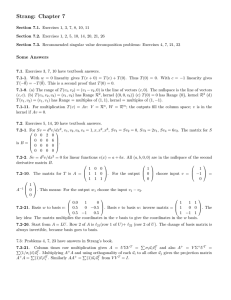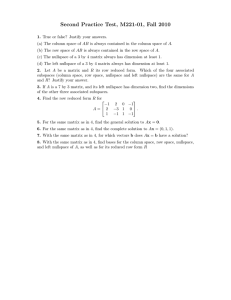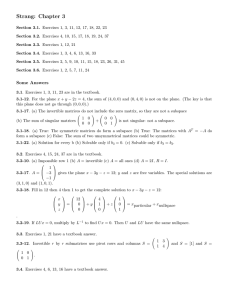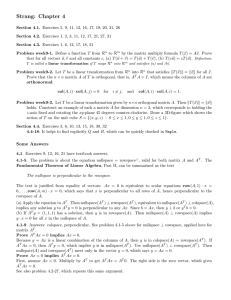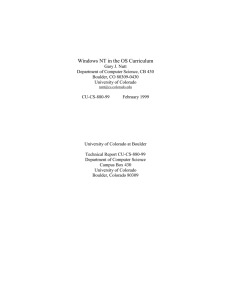Linear Algebra 2270-2
advertisement
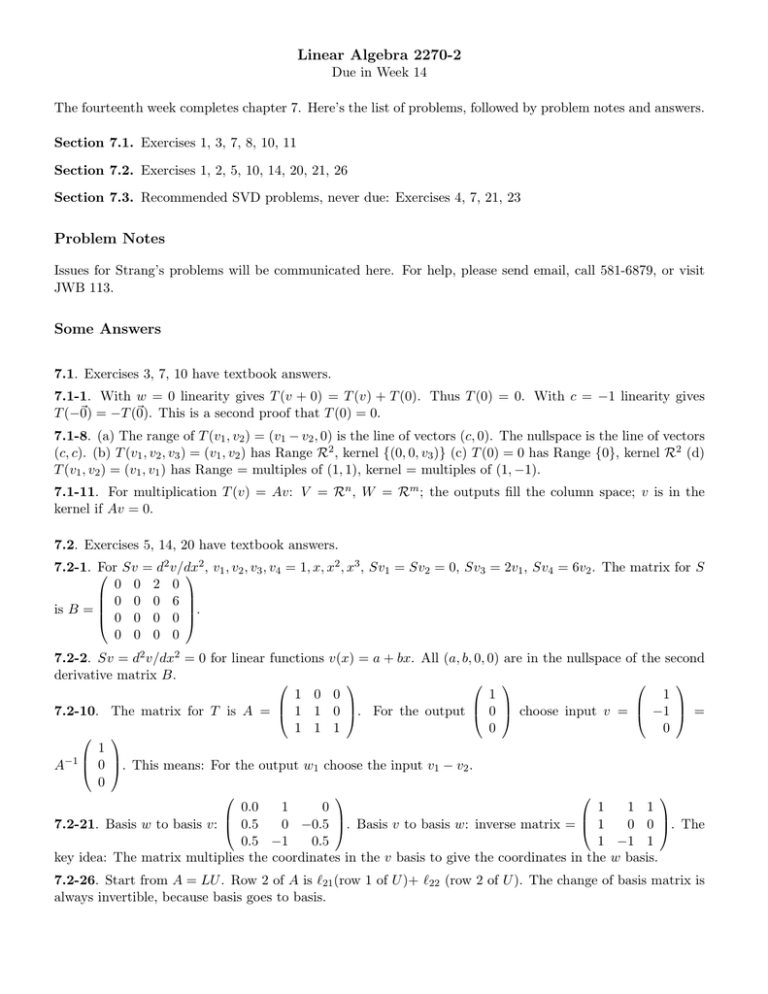
Linear Algebra 2270-2
Due in Week 14
The fourteenth week completes chapter 7. Here’s the list of problems, followed by problem notes and answers.
Section 7.1. Exercises 1, 3, 7, 8, 10, 11
Section 7.2. Exercises 1, 2, 5, 10, 14, 20, 21, 26
Section 7.3. Recommended SVD problems, never due: Exercises 4, 7, 21, 23
Problem Notes
Issues for Strang’s problems will be communicated here. For help, please send email, call 581-6879, or visit
JWB 113.
Some Answers
7.1. Exercises 3, 7, 10 have textbook answers.
7.1-1. With w = 0 linearity gives T (v + 0) = T (v) + T (0). Thus T (0) = 0. With c = −1 linearity gives
T (−~0) = −T (~0). This is a second proof that T (0) = 0.
7.1-8. (a) The range of T (v1 , v2 ) = (v1 − v2 , 0) is the line of vectors (c, 0). The nullspace is the line of vectors
(c, c). (b) T (v1 , v2 , v3 ) = (v1 , v2 ) has Range R2 , kernel {(0, 0, v3 )} (c) T (0) = 0 has Range {0}, kernel R2 (d)
T (v1 , v2 ) = (v1 , v1 ) has Range = multiples of (1, 1), kernel = multiples of (1, −1).
7.1-11. For multiplication T (v) = Av: V = Rn , W = Rm ; the outputs fill the column space; v is in the
kernel if Av = 0.
7.2. Exercises 5, 14, 20 have textbook answers.
2
2 3
7.2-1.
For Sv = d2 v/dx
, v1 , v2 , v3 , v4 = 1, x, x , x , Sv1 = Sv2 = 0, Sv3 = 2v1 , Sv4 = 6v2 . The matrix for S
0 0 2 0
0 0 0 6
is B =
.
0 0 0 0
0 0 0 0
7.2-2. Sv = d2 v/dx2 = 0 for linear functions v(x) = a + bx. All (a, b, 0, 0) are in the nullspace of the second
derivative matrix B.
1 0 0
1
1
7.2-10. The matrix for T is A = 1 1 0 . For the output 0 choose input v = −1 =
1 1 1
0
0
1
A−1 0 . This means: For the output w1 choose the input v1 − v2 .
0
0.0
1
0
1
1 1
0 −0.5 . Basis v to basis w: inverse matrix = 1
0 0 . The
7.2-21. Basis w to basis v: 0.5
0.5 −1
0.5
1 −1 1
key idea: The matrix multiplies the coordinates in the v basis to give the coordinates in the w basis.
7.2-26. Start from A = LU . Row 2 of A is `21 (row 1 of U )+ `22 (row 2 of U ). The change of basis matrix is
always invertible, because basis goes to basis.
